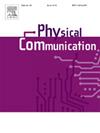Secure transmission OFDMA VLC in presence of external jammer: Perfect and imperfect CSI
IF 2
4区 计算机科学
Q3 ENGINEERING, ELECTRICAL & ELECTRONIC
引用次数: 0
Abstract
Secure transmission in visible light communication (VLC) is very important. Hence, in this paper, we investigate physical layer security (PLS) in downlink of orthogonal frequency-division multiple access (OFDMA), in the presence of multiple eavesdroppers (Eve), multi users, and an external jammer. It is necessary to mention that in the future networks the users need to service continually. Hence, the Time Division Multiple Access (TDMA) method is not compatible for this application, to tackle this issue, we use OFDMA technique. Moreover, due to its orthogonal subcarriers, OFDMA minimizes inter-user interference. This leads to a lower bit error rate compared to non-orthogonal multiple access in most scenarios. Specially, this metric is very vital in the medical application, hence, we investigate OFDMA in this work. Our intention is to improve sum secrecy rate (SSR); hence, we propose an optimization problem to assign the subcarrier and power to users, subject to power limitation and OFDMA requirements. Moreover, since Eve is passive, the Channel State Information (CSI) of Eves may be not available, hence, we investigate two scenarios, perfect and imperfect CSI. Sine the proposed optimization problem is non-convex and complicated, we utilize the well-known iterative algorithm called the Alternative Search Method (ASM). This algorithm breaks down the optimization problem into two subproblems: power allocation and subcarrier allocation. Since the power allocation optimization problem is non-convex, we employ difference of two concave functions (DC) approximation and epigraph method, to approximate it to convex one. Since subcarrier allocation optimization problem consists of binary variables, we employ the Mesh Adaptive Direct Search algorithm (MADS) to solve it. The simulation results show that in the proposed system model, it is not necessary to employ a photodiode with high physical area the reason is that secrecy rate is saturated in high value of physical area photodiode.
安全传输OFDMA VLC在存在外部干扰:完美和不完美的CSI
在可见光通信(VLC)中,安全传输是非常重要的。因此,在本文中,我们研究了正交频分多址(OFDMA)下行链路中存在多个窃听者(Eve)、多用户和外部干扰器的物理层安全性(PLS)。必须提到的是,在未来的网络中,用户需要持续服务。因此,时分多址(TDMA)方法不适合这种应用,为了解决这个问题,我们使用OFDMA技术。此外,由于其正交子载波,OFDMA最大限度地减少了用户间的干扰。在大多数情况下,与非正交多路访问相比,这导致了较低的误码率。特别是,这个度量在医疗应用中是非常重要的,因此,我们在这项工作中研究OFDMA。我们的目的是提高总和保密率(SSR);因此,我们提出了一个优化问题,在功率限制和OFDMA要求的情况下,将子载波和功率分配给用户。此外,由于Eve是被动的,因此可能无法获得Eve的通道状态信息(CSI),因此我们研究了两种情况,即完全CSI和不完全CSI。由于所提出的优化问题是非凸且复杂的,我们使用了著名的迭代算法,称为替代搜索法(ASM)。该算法将优化问题分解为功率分配和子载波分配两个子问题。由于功率分配优化问题是一个非凸问题,我们采用两凹函数差分法(DC)逼近法和铭文法将其逼近为凸问题。由于子载波分配优化问题是由二元变量组成的,我们采用网格自适应直接搜索算法(MADS)来解决该问题。仿真结果表明,在所提出的系统模型中,不需要使用高物理面积的光电二极管,因为在高物理面积的光电二极管中,保密率已经饱和。
本文章由计算机程序翻译,如有差异,请以英文原文为准。
求助全文
约1分钟内获得全文
求助全文
来源期刊

Physical Communication
ENGINEERING, ELECTRICAL & ELECTRONICTELECO-TELECOMMUNICATIONS
CiteScore
5.00
自引率
9.10%
发文量
212
审稿时长
55 days
期刊介绍:
PHYCOM: Physical Communication is an international and archival journal providing complete coverage of all topics of interest to those involved in all aspects of physical layer communications. Theoretical research contributions presenting new techniques, concepts or analyses, applied contributions reporting on experiences and experiments, and tutorials are published.
Topics of interest include but are not limited to:
Physical layer issues of Wireless Local Area Networks, WiMAX, Wireless Mesh Networks, Sensor and Ad Hoc Networks, PCS Systems; Radio access protocols and algorithms for the physical layer; Spread Spectrum Communications; Channel Modeling; Detection and Estimation; Modulation and Coding; Multiplexing and Carrier Techniques; Broadband Wireless Communications; Wireless Personal Communications; Multi-user Detection; Signal Separation and Interference rejection: Multimedia Communications over Wireless; DSP Applications to Wireless Systems; Experimental and Prototype Results; Multiple Access Techniques; Space-time Processing; Synchronization Techniques; Error Control Techniques; Cryptography; Software Radios; Tracking; Resource Allocation and Inference Management; Multi-rate and Multi-carrier Communications; Cross layer Design and Optimization; Propagation and Channel Characterization; OFDM Systems; MIMO Systems; Ultra-Wideband Communications; Cognitive Radio System Architectures; Platforms and Hardware Implementations for the Support of Cognitive, Radio Systems; Cognitive Radio Resource Management and Dynamic Spectrum Sharing.
 求助内容:
求助内容: 应助结果提醒方式:
应助结果提醒方式:


